The Northernmost Town in the World Is Home to Polar Bears, Arctic Adventures, and Fine-dining Restaurants — Here's What It's Like to Visit
- Oops!Something went wrong.Please try again later.
Longyearbyen, located not far from the North Pole, is an ideal destination for outdoor adventure lovers.
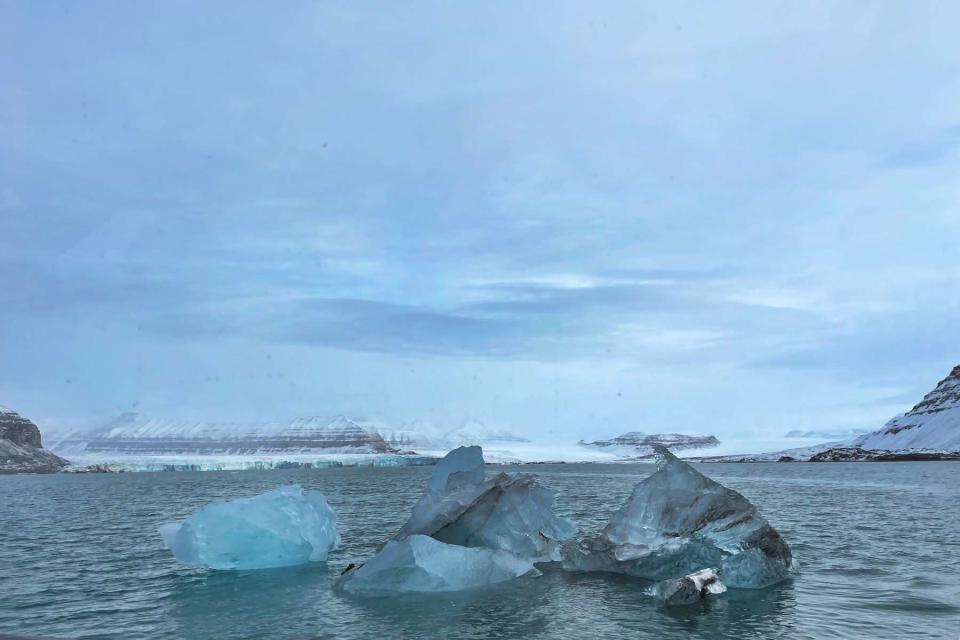
Sarah Kuta
You likely won't come face to face with a polar bear while visiting Longyearbyen, the northernmost town in the world, but there's a chance you might — and if you do, the encounter could be bad news for you, the bear, or both. That's why my guide, Cécily Noaillac, a French scientist studying geophysics in the region, paused our e-bike trek to load the powerful (and required for the trek) rifle she’d been carrying in her backpack. As we prepared to pedal outside the bounds of the settlement, located on the Norwegian-governed archipelago of Svalbard not far from the North Pole, we needed polar bear protection — warning signs posted all over town remind travelers of this mandate.
Though these precautionary measures may seem extreme, they make perfect sense in a place far above the Arctic Circle, where there are more polar bears than people — 3,000 bears in the region versus 2,500 inhabitants. With enormous white-blue glaciers, frigid waters dotted with chunks of sea ice, and miles of vast Arctic tundra to explore via snowmobile, dog sled, or skis, Svalbard is an outdoor adventure lover’s dream — people visit (and move here) from all over the world to take advantage of the unparalleled access to actually wild nature. It’s basically the edge of the world.
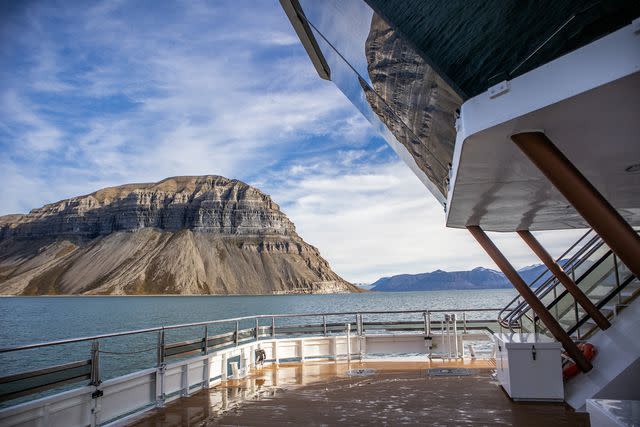
Courtesy of Hurtigruten
Ever since I watched my first Planet Earth episode — and heard Sir David Attenborough skillfully narrate the plights and escapades of cold-climate pros like polar bears, seals, whales, walruses, and birds — I’ve wanted to visit the Arctic, so I jumped at the invitation to travel to Svalbard, where next summer Hurtigruten will bring back its historic Svalbard Express cruise aboard the rejuvenated MS Trollfjord. The route, which is relaunching just in time to help celebrate Hurtigruten’s 130th anniversary, will take travelers up and down the scenic Norwegian coast, with a multiday stopover — and plenty of time for Arctic adventures — in Longyearbyen.
Svalbard’s Evolution
Despite the challenges that come with living in such a remote, rugged place — avalanches, unpredictable weather, potential wildlife encounters, 24-hour darkness for several months of the year, and 24-hour daylight for several others, to name a few — the people who live in Longyearbyen are incredibly warm and chatty, even with obvious tourists like me. That's due largely to the fact that it’s such a small, isolated town in the middle of nowhere, but also because most residents move here, mostly on their own, for a few years of work or school — hardly anyone is actually “from” Svalbard. There are more than 50 nationalities represented at any given time.
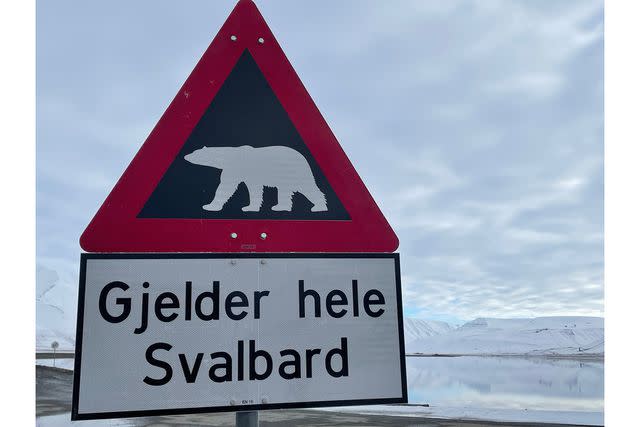
Sarah Kuta
“This is a place where people actively choose to move and, in most cases, they don’t know anyone when they first come up here,” says Per Brochmann, CEO of Hurtigruten Svalbard, which runs an array of expeditions, hotels, restaurants, and other adventures in Longyearbyen. “This makes Longyearbyen a very open community, with friendly people who always have a helping hand or a cup of coffee to offer.”
Fortune-seeking whalers first began populating the archipelago in the early 1600s, followed by hunters and trappers and, eventually, coal miners in the early 1900s. These days, Svalbard has become a massive hub for science, with researchers at the University Centre in Svalbard (UNIS) studying everything from glaciers to the northern lights to, yes, polar bears.
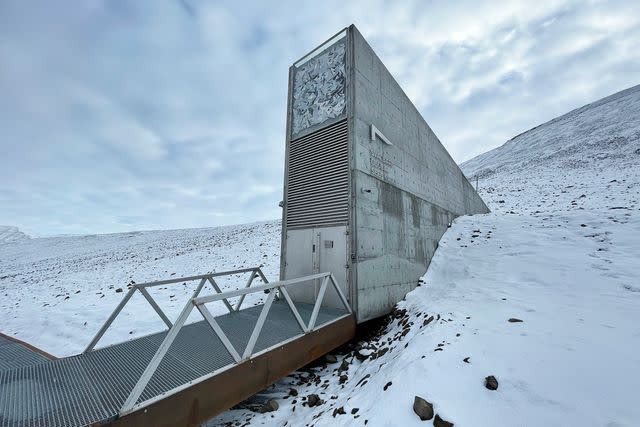
Sarah Kuta
To that same end, Longyearbyen is also home to the Svalbard Global Seed Vault, a climate-controlled doomsday bunker that contains millions of backup seeds from around the globe. The vault, which is carved into solid rock and first opened in 2008, is basically a long-term insurance plan for crop diversity. If a natural or human-caused disaster were to strike (or, if something even more mundane were to happen, like mismanagement or a loss of funding at local or regional seed banks), society could begin to rebuild by planting seeds tucked safely away in the Svalbard hillside. The vault itself is not open to the public, but visitors can walk around the outside of the concrete entry portal, which features Norwegian artist Dyveke Sanne’s stunning fiber optic art installation, “Perpetual Repercussion.”
Incomparable Experiences and Fine-dining Restaurants
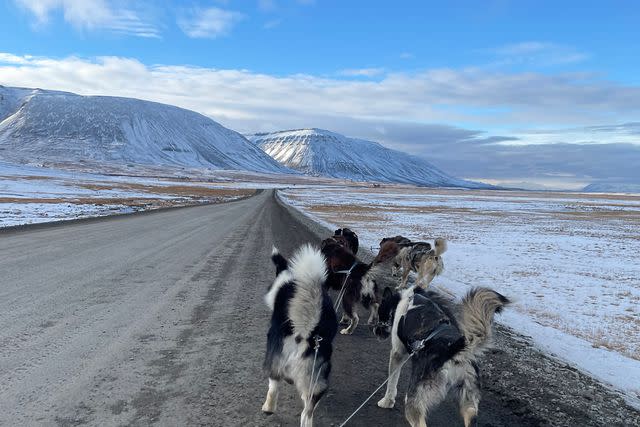
Sarah Kuta
Other unique, only-in-the-Arctic activities abound on Svalbard, like driving a team of amped-up sled dogs through the sun-dappled valley with Green Dog Svalbard or eagerly peering through binoculars to watch majestic minke whales, nimble white-beaked dolphins, and adorable puffins on a sightseeing trip aboard the hybrid-electric catamaran MS Bard. The hybrid speedboat Kvitbjørn helps travelers get up close and personal with glaciers and check out various historical landmarks around the archipelago, like Villa Fredheim, the longtime home of trapper — and local legend — Hilmar Nøis. Wandering through the charming North Pole Expedition Museum, I also learned about the many innovative (and daring) attempts to reach the North Pole throughout history. Guided hikes, fishing trips, fossil hunts, ATV expeditions, historic mine tours, cross-country ski treks, kayak trips, and other adventures also offer a window into Svalbard’s rich history and time-worn landscape.
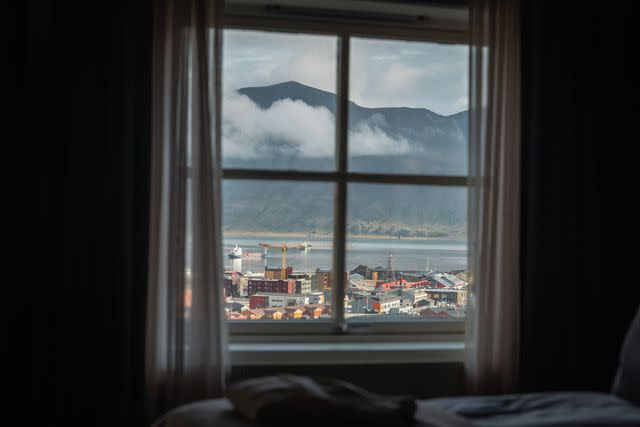
Stephen Gollan/Courtesy of Hurtigruten
Perhaps a little surprising for such a far-flung destination, where nearly everything must be shipped or flown in, Longyearbyen also has a thriving food and drink scene. Huset, for instance, is located inside a historic 1951 building that has played many important roles over the years — as a post office, community gymnasium, and general store for miners and hunters. Today, the high-end eatery serves thoughtful Nordic cuisine featuring local ingredients like seal, reindeer, ptarmigan, kelp, mountain sorrel, seaweed, and a variety of seafood. It's also home to an award-winning, 15,000-bottle wine cellar, which is one of the largest in all of Scandinavia. Funktionærmessen Restaurant — located inside the cozy, boutique Funken Lodge hotel, which once housed coal mining executives — offers four- and seven-course tasting menus with decadent dishes like shellfish “cappuccino” soup and grilled secreto Ibérico pork.
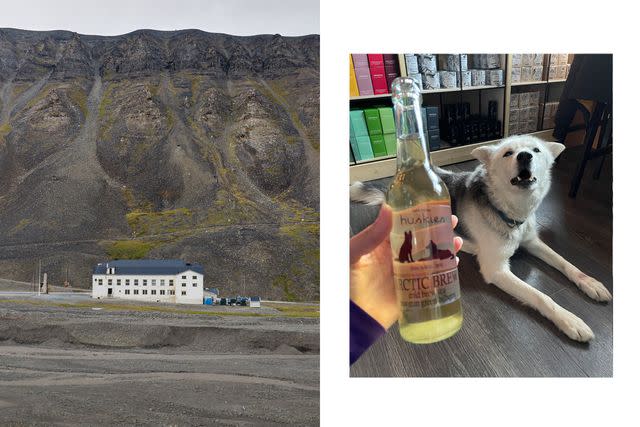
From left: Stephen Gollan/Courtesy of Hurtigruten; Sarah Kuta
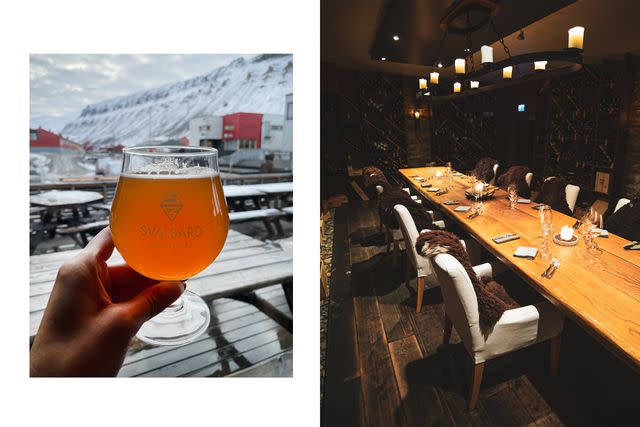
From left: Sarah Kuta; Bjoern A. Bjerke/Courtesy of Hurtigruten
On the more casual side, there's an array of pubs, bars, relaxed restaurants, and cafes, many of them serving up tasty craft beer from Svalbard Brewery (or bryggeri, in Norwegian), which is the northernmost brewery in the world. But by far the cutest, most heartwarming spot to grab a bite in town is Café Huskies, a relatively new hangout that’s part coffee shop, part doggy daycare for gentle, well-behaved huskies. A friendly dog or two might greet you at the door, wait patiently while you order a chai, then daintily hop up onto the couch next to you while you read or type away on your laptop. Not an exaggeration — if you’re a dog lover, Café Huskies alone is worth planning a trip to Longyearbyen.
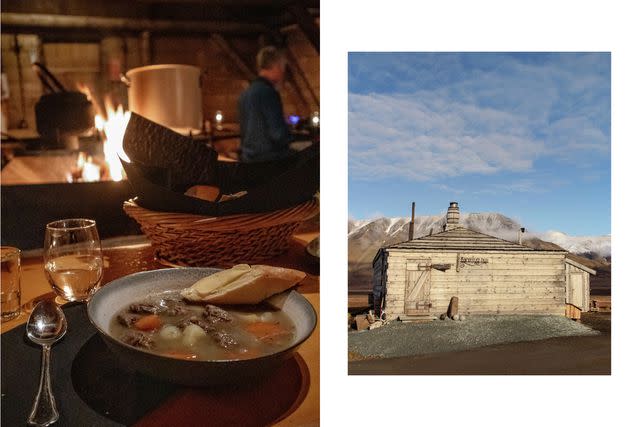
From left: Eveline Lunde; Agurtxane Concellon/Courtesy of Hurtigruten
One of the most unique eating and drinking experiences you can have on Svalbard takes place several miles outside of town at Camp Barentz. Dine inside Barentz Hus, a replica of the rustic cabin that Willem Barentsz — the Dutch explorer who's credited with first discovering Svalbard — and his crew built to survive the polar winter during a failed 1596 expedition to chart a northeast passage to Asia. While a knowledgeable historian explained the many perils of Barentz’s Arctic adventures and discussed the life cycle of polar bears, I sipped aptly named Barents aquavit and warmed my hands on a bowl of bidos, or hearty reindeer stew.
When my trip to Svalbard finally came to an end, I was bummed to be leaving such a once-in-a-lifetime destination. But I know I’ll be back — there are so many “northernmost” experiences I still need to have.
For more Travel & Leisure news, make sure to sign up for our newsletter!
Read the original article on Travel & Leisure.

